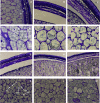Bioprocessing of common pulses changed seed microstructures, and improved dipeptidyl peptidase-IV and α-glucosidase inhibitory activities
- PMID: 31653886
- PMCID: PMC6814730
- DOI: 10.1038/s41598-019-51547-5
Bioprocessing of common pulses changed seed microstructures, and improved dipeptidyl peptidase-IV and α-glucosidase inhibitory activities
Abstract
Type 2 diabetes mellitus (T2DM) is a leading cause of death globally. T2DM patients experience glucose intolerance, and inhibitors of dipeptidyl peptidase IV (DPP-IV) and α-glucosidase are used as drugs for T2DM management. DPP-IV and α-glucosidase inhibitors are also naturally contained in foods, but their potency can be affected by the food matrix and processing methods. In this study, germination and solid-state fermentation (SSF) were used to alter pulse seed microstructures, to convert compounds into more bioactive forms, and to improve their bioaccessibility. Germination substantially modified the seed microstructure, protein digestibility, contents and profiles of phenolic compounds in all the pulses. It also increased DPP-IV and α-glucosidase inhibitory activities in chickpeas, faba beans and yellow peas. Compared to germination, SSF with Lactobacillus plantarum changed the content and the profile of phenolic compounds mainly in yellow peas and green lentils because of greater disruption of the seed cell wall. In the same pulses, heat treatment and SSF of flour increased DPP-IV and α-glucosidase inhibitory activities. The results of this study suggest that germination and SSF with L. plantarum are effective and simple methods for modulating phenolic and protein profiles of common pulses and improve the action on DPP-IV and α-glucosidase.
Conflict of interest statement
The authors declare no competing interests.
Figures




Similar articles
-
Anti-α-glucosidase and Anti-dipeptidyl Peptidase-IV Activities of Extracts and Purified Compounds from Vitis thunbergii var. taiwaniana.J Agric Food Chem. 2015 Jul 22;63(28):6393-401. doi: 10.1021/acs.jafc.5b02069. Epub 2015 Jul 13. J Agric Food Chem. 2015. PMID: 26138774
-
Inhibitory evaluation of Curculigo latifolia on α-glucosidase, DPP (IV) and in vitro studies in antidiabetic with molecular docking relevance to type 2 diabetes mellitus.J Enzyme Inhib Med Chem. 2021 Dec;36(1):109-121. doi: 10.1080/14756366.2020.1844680. J Enzyme Inhib Med Chem. 2021. PMID: 33249946 Free PMC article.
-
Identification of novel dipeptidyl peptidase IV and α-glucosidase inhibitory peptides from Tenebrio molitor.Food Funct. 2021 Jan 21;12(2):873-880. doi: 10.1039/d0fo02696d. Epub 2021 Jan 7. Food Funct. 2021. PMID: 33410437
-
Preparation, structural properties, and in vitro and in vivo activities of peptides against dipeptidyl peptidase IV (DPP-IV) and α-glucosidase: a general review.Crit Rev Food Sci Nutr. 2024;64(27):9844-9858. doi: 10.1080/10408398.2023.2217444. Epub 2023 Jun 13. Crit Rev Food Sci Nutr. 2024. PMID: 37310013 Review.
-
Identification and molecular docking study of sugarcane leaf-derived compounds as potent dipeptidyl peptidase IV, α-glucosidase, and α-amylase inhibitors.J Sci Food Agric. 2023 Aug 30;103(11):5388-5400. doi: 10.1002/jsfa.12613. Epub 2023 May 21. J Sci Food Agric. 2023. PMID: 37038045 Review.
Cited by
-
Faba Bean Processing: Thermal and Non-Thermal Processing on Chemical, Antinutritional Factors, and Pharmacological Properties.Molecules. 2023 Jul 15;28(14):5431. doi: 10.3390/molecules28145431. Molecules. 2023. PMID: 37513301 Free PMC article. Review.
-
Bioavailability of Melatonin from Lentil Sprouts and Its Role in the Plasmatic Antioxidant Status in Rats.Foods. 2020 Mar 12;9(3):330. doi: 10.3390/foods9030330. Foods. 2020. PMID: 32178261 Free PMC article.
-
Riceberry Rice Germination and UVB Radiation Enhance Protocatechuic Acid and Vanillic Acid to Reduce Cellular Oxidative Stress and Suppress B16F10 Melanogenesis Relating to F-Actin Rearrangement.Plants (Basel). 2023 Jan 20;12(3):484. doi: 10.3390/plants12030484. Plants (Basel). 2023. PMID: 36771569 Free PMC article.
-
Health Beneficial Bioactivities of Faba Bean Gastrointestinal (In Vitro) Digestate in Comparison to Soybean and Pea.Int J Mol Sci. 2022 Aug 16;23(16):9210. doi: 10.3390/ijms23169210. Int J Mol Sci. 2022. PMID: 36012479 Free PMC article.
-
Optimized Fermentation Conditions of Pulses Increase Scavenging Capacity and Markers of Anti-Diabetic Properties.Antioxidants (Basel). 2025 Apr 27;14(5):523. doi: 10.3390/antiox14050523. Antioxidants (Basel). 2025. PMID: 40427404 Free PMC article.
References
-
- American Diabetes Association, A. D. 3. Foundations of Care and Comprehensive Medical Evaluation. Diabetes Care. 2016;39(Suppl 1):S23–35. - PubMed
-
- Global report on diabetes. ISBN 978 92 4 156525 7978, (WHO Library Cataloguing-in-Publication Data, 2016).
-
- Lacroix IME, Li-Chan ECY. Overview of food products and dietary constituents with antidiabetic properties and their putative mechanisms of action: A natural approach to complement pharmacotherapy in the management of diabetes. Mol. Nutr. Food Res. 2014;58:61–78. doi: 10.1002/mnfr.201300223. - DOI - PubMed
Publication types
MeSH terms
Substances
LinkOut - more resources
Full Text Sources

